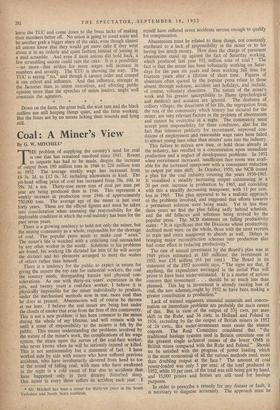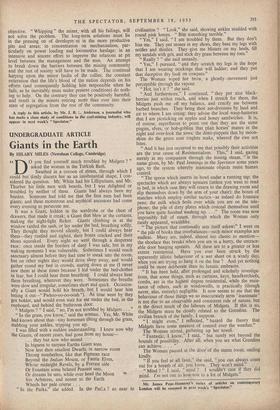Coal : 'A Miner's View By G. W. MITCHELL* T HE
problem of supplying the country's need for coal is one that has remained unsolved since 1945. Resort to imports has had to be made, despite the increase of output from 190 million tons in 1946 to 226 million tons in 1952. The average weekly wage has increased from £6 3s. 2d. to £12 Os. 7d. including allowances in kind. The pit-head selling price of coal has increased from 38s. 10d. to 59s. 3d. a ton. Thirty-nine more tons of coal per man per year are being produced than in 1946. This represents a weekly increase in production over 1946 of approximately 750,000 tons. The average age of the miner is just over forty years. These are the official figures and must be taken into consideration when assessing the responsibility for the deplorable condition in which the coal industry has been for the past seven years. There is a growing tendency to hold not only the miner, but the mining community as a whole, responsible for the shortage of coal. The popular press tends to make coal " news." The miner's life is watched with a criticising zeal unmatched by any other worker in the world. Solutions to his problems are found, his working life dictated for him (if he will accept the dictate) and his pleasures arranged to meet the wishes of others rather than himself.
There is a tendency for the ,public to expect in return for giving the miners the top rate for industrial workers, the coal the country needs, disregarding human and physical con- siderations. As one with thirty-six years' experience in the pits, and twenty years a coal-face worker, I believe it is physically impossible for the miner individually to produce, under the mechanised methods now in use, more coal than he does at present. Absenteeism will of course be thrown at me here. I believe the real issues are being lost under the clouds of smoke that arise from the fires of this controversy. This is not a new problem; it has been common to the mines during the whole of my lifetime, and will remain with us until a sense of responsibility to the miners is felt by the public. This means understanding the problems involved by the nature of the miner's work, the complications of his wage system, the strain upon the nerves of the coal-face worker, who never knows when he will be seriously injured or killed. This is not sentimentality but a statement of fact. I have worked side by side with miners who have suffered previous accidents, who have involuntarily shivered from head to toe at the sound of falling coal; with men who have awakened in the night in a cold sweat of fear due to accidents that have happened only in their dreamy disturbed sleep. One miner in every three suffers an accident each year. I
• Mr. Mitchell has been a miner for thirty-six years in the South Yorkshire and North Notts coalfields.
myself have suffered seven accidents serious enough to qualify for compensation. Absenteeism must be related to these thing's, not constantly attributed to a lack of responsibility in the miner or to his having too much money. How does the charge of persistent absenteeism stand up against the fact of Saturday working, which produced last year 101 million tons of coal ? The fact is that the miner has been voluntarily working on Satur- days for the past six years and been working full time for fourteen years after a lifetime of short time. Figures of absentees often quoted by the popular press relate to those absent through sickness, accident and holidays, and include, of course, voluntary absentees. The nature of the miner's work and his greater spsceptibility to illness (psychological and medical) and accident are ignored. The drabness of colliery villages, the dreariness of his life, the segregation from. the rest of the community which history has dictated for the miner, are very relevant factors in the problem of absenteeism and cannot be overcome in a night. The community must accept joint responsibility for these conditions, also for the fact that intensive publicity for recruitment, improved con- ditions of employment and reasonable wage rates have failed to attract young men other than miners' sons into the industry.
This failure to recruit new men, or hold those already in the industry, has resulted in a concentration upon immediate production and a neglect of development problems. In .1952 when recruitment increased, insufficient face room was avail- able for the increased manpower with a consequent reduction In output per man shift. In October, 1950, the NCB issued a plan for the coal industry covering the years 1950-1965. It visualised a steadily increasing output culminating in a 20 per cent. increase in production by 1965, and coinciding with this a steadily decreasing manpower, with 11 per cent. less in 1965. This plan appeared to be a realistic approach to the problems involved, and suggested that efforts towards a permanent solution were being made. Yet in less than three years we find the plan falling sadly behind schedule, and the old fallacies and solutions being revived by the popular press. The NCB statement on falling productivity states: "It is significant that the Divisions whose productivity declined most were, on the whole, those with the most recruits to train and extra manpower to absorb as well. Delays in bringing major reconstruction schemes into production also had some effect in reducing productivity." • The rate of annual investment by the Board's plan was at 1949 prices estimated at £60 millions; the investment in 1952 was £38 million (64 per cent.). The Board in its statement of the 1952 accounts says, " The signs are that, if anything, the expenditure envisaged in the initial Plan will prove to have been under-estimated. It is a matter of serious concern that investment . . . should be so much less than planned. This lag in investment is already causing loss of coal, the new schemes ,ought by 1952 to have been making a greater contribution to production."
Lack of trained engineers, essential materials and concen- tration on immediate problems are probably the main causes of this. But in view of the output of 331 cwts. per man shift in the Ruhr, and 36 cwts. in Holland and Poland in 1936, exceeding by far the output of British miners in 1952 of 24 cwts., this under-investment must cause the utmost concern. The Reid Committee considered that " the traditional haulage systems used in Britain constitute one of the greatest single technical causes of the lower OMS in British mines compared with the Ruhr and Poland." Should we be satisfied with the progress of power loading which is the most economical of all the various methods used, more than doubling output at the face ? The amount of coal power-loaded was only 5 per cent. of the total produced in 1952, while 10 per cent. of the total was still being got by hand, and 15,000 ponies and horses are still used for haulage purposes.
In order to prescribe a remedy for any disease or fault, it is necessary to diagnose accurately. The approach must be objective. " Whipping " the miner, with all his failings, will not solve the problem. The long-term solutions must lie in the pressing on of developmi-nt in the more productive pits and areas; in concentration on mechanisation, par- ticularly on power loading and locomotive haulage; in an intensive and sincere effort to improve the relations at pit level between the management and the men. An attempt to break down the barriers between the mining community and the rest of society will have to be made. The continual harping upon the minor faults of the collier, the constant reiteration that the life's blood of the nation depends on his efforts (and consequently holding him responsible when he fails, as he inevitably must under present conditions) do noth- ing to help. On the contrary they can be positively harmful, and result in the miners retiring more than ever into their state of segregation from the rest of the community.
A reply to this article, by Mr. J. R. L Anderson, a journalist who has made a close study of conditions In the coal-mining industry, will appear in next week's "Spectator."



































 Previous page
Previous page